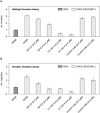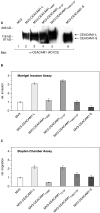CEACAM1 enhances invasion and migration of melanocytic and melanoma cells
- PMID: 15509546
- PMCID: PMC1618678
- DOI: 10.1016/S0002-9440(10)63433-5
CEACAM1 enhances invasion and migration of melanocytic and melanoma cells
Abstract
Expression of the cell adhesion molecule CEACAM1 in melanomas is an independent factor for the risk of metastasis with a predictive value superior to that of tumor thickness. We have previously shown that CEACAM1 co-localizes at the tumor-stroma interface of invading melanoma masses with integrin beta(3) and that these two adhesion molecules interact via the CEACAM1 cytoplasmic domain. To address the functional consequences of CEACAM1 expression, we investigated invasion and migration of melanocytic and melanoma cells that stably express CEACAM1 using two different in vitro systems. Here, we demonstrate that CEACAM1 expression markedly enhances cell invasion and migration. The enhanced invasion and migration of CEACAM1-transfected cells was dependent on the presence of Tyr-488 within the full-length cytoplasmic CEACAM1 domain. Treatment with anti-CEACAM monoclonal antibodies blocked CEACAM1-enhanced cell invasion and cell migration in a dose-dependent manner. Furthermore, the enhanced invasion and migration of CEACAM1-transfected melanoma cells was blocked by integrin-antagonizing RGD peptides. Expression of integrin beta(3) induces the up-regulation of CEACAM1 in melanocytic MEL6 cells. These results strengthen the view that CEACAM1 and alpha(v)beta(3) integrin are functionally interconnected with respect to the invasive growth of melanomas.
Figures






References
-
- Edward M. Integrins and other adhesion molecules involved in melanocytic tumor progression. Curr Opin Oncol. 1995;7:185–191. - PubMed
-
- Buttner P, Garbe C, Bertz J, Burg G, d’Hoedt B, Drepper H, Guggenmoos-Holzmann I, Lechner W, Lippold A, Orfanos CE, Peters A, Rassner G, Stadler R, Stroebel W. Primary cutaneous melanoma. Optimized cutoff points of tumor thickness and importance of Clark’s level for prognostic classification. Cancer. 1995;75:2499–2506. - PubMed
-
- Johnson JP. Cell adhesion molecules in the development and progression of malignant melanoma. Cancer Metastasis Rev. 1999;18:345–357. - PubMed
-
- Natali PG, Hamby CV, Felding-Habermann B, Liang B, Nicotra MR, Di Filippo F, Giannarelli D, Temponi M, Ferrone S. Clinical significance of alpha(v)beta3 integrin and intercellular adhesion molecule-1 expression in cutaneous malignant melanoma lesions. Cancer Res. 1997;57:1554–1560. - PubMed
Publication types
MeSH terms
Substances
LinkOut - more resources
Full Text Sources
Other Literature Sources
Medical
Miscellaneous

